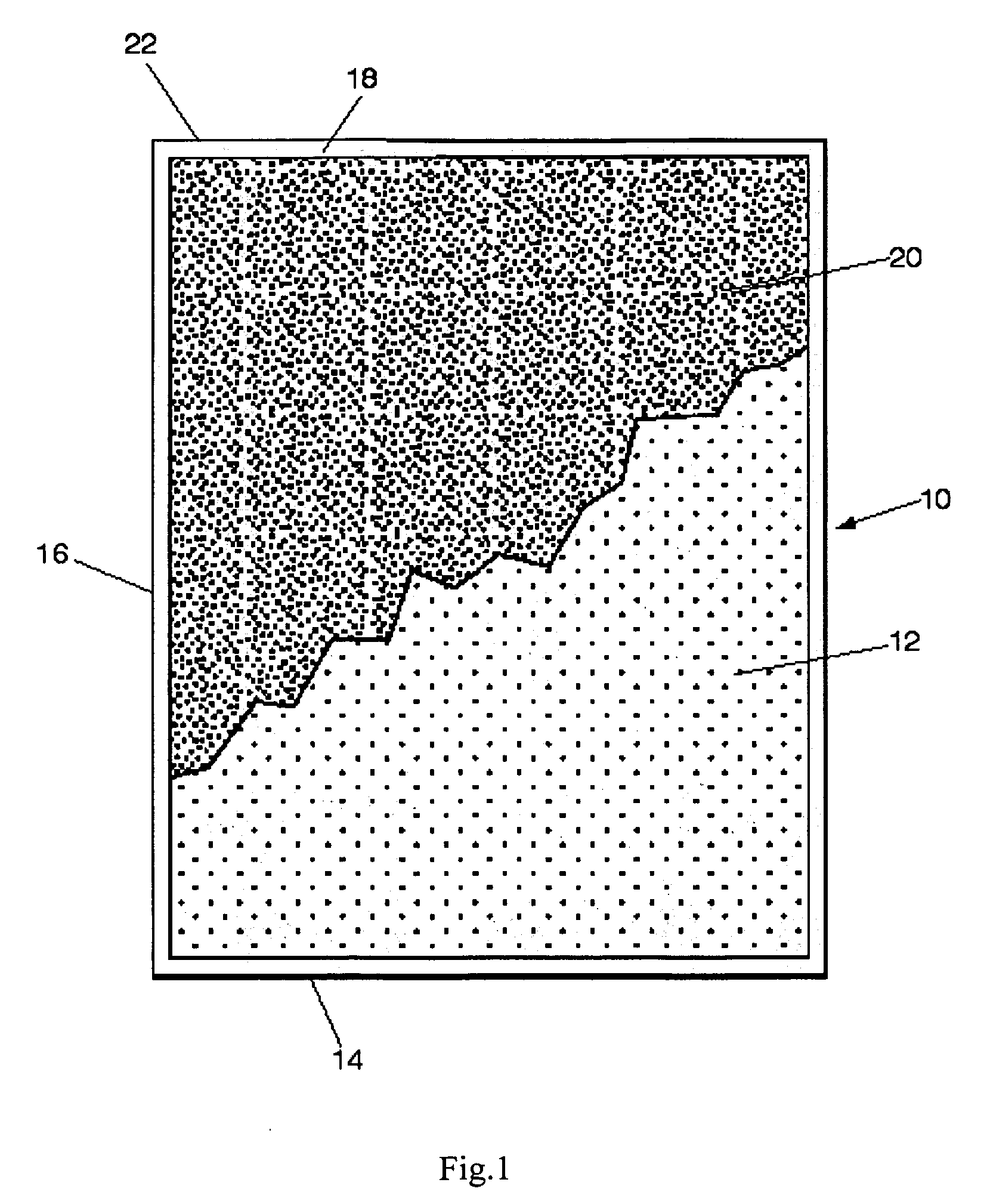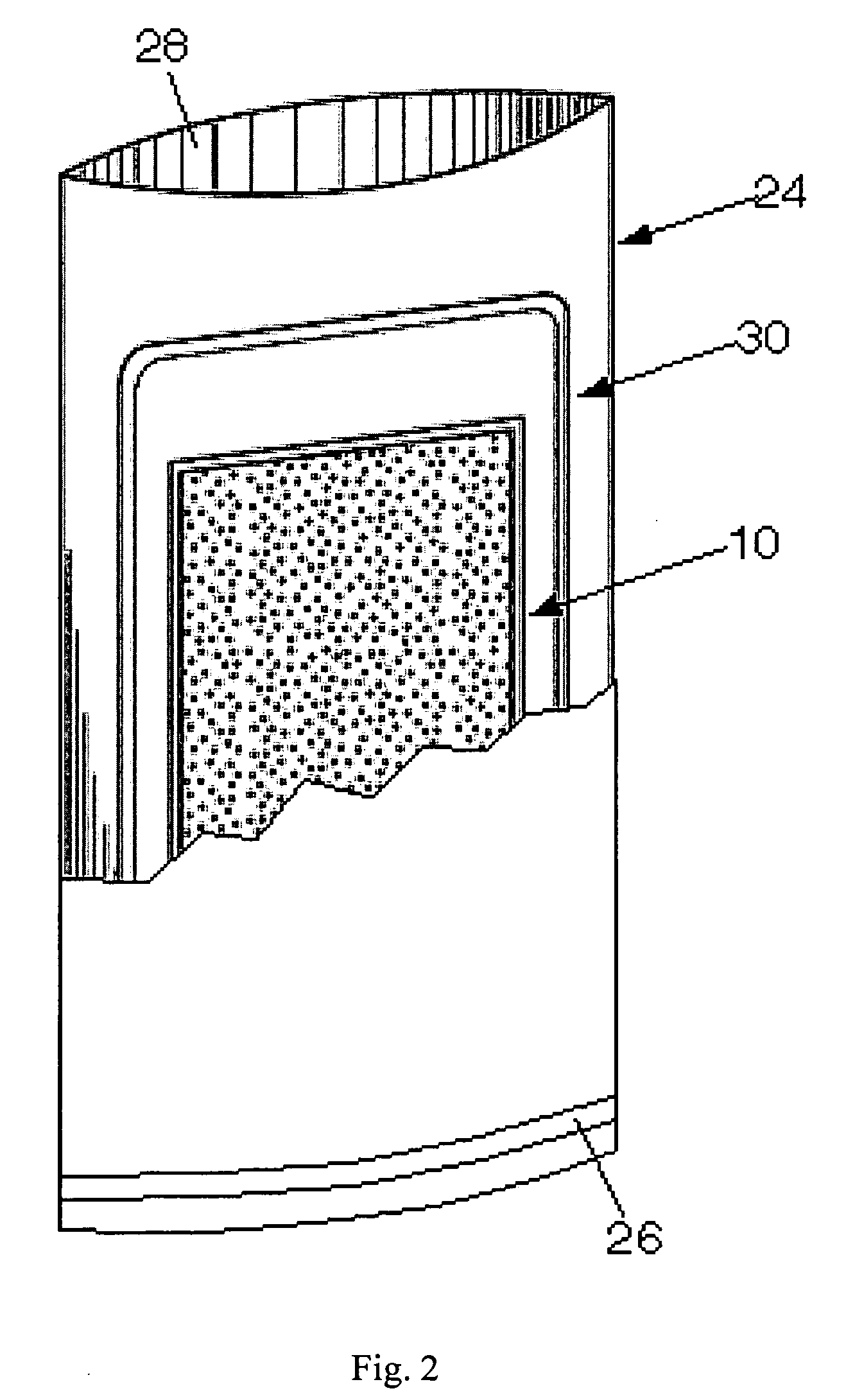Hydrogen elimination and thermal energy generation in water-activated chemical heaters
- Summary
- Abstract
- Description
- Claims
- Application Information
AI Technical Summary
Benefits of technology
Problems solved by technology
Method used
Image
Examples
example 1
[0036]In order to demonstrate the details of the invention based on a Mg / MnO2+H2O system according to the equation [1] below, the following experiment was conducted:
Mg+2 MnO2+H2O→Mg(OH)2+Mn2O3[1]
[0037]A 99.98% pure Mg metal sample of 500μ particle size from Superior Metal Powders, Franklin, Pa., was used in this test, and contained trace amounts, i.e., 85 ppm Al, 4 ppm Cu, 300 ppm Fe, 250 ppm Mn, 50 ppm Na, 150 ppm Si, 100 ppm Zn, and 50 ppm Ca. In addition, a 300μ size γ-MnO2 powder from Tronox, LLC, Henderson, Nev., was used with a purity of 99%. The γ-MnO2 contained trace amounts, i.e., 8600 ppm S, 2600 ppm Ca, <100 ppm Mg, <1000 ppm Al, <100 ppm Si, <100 ppm Cl, 700 ppm K, <1000 ppm Cr, and <100 Sn ppm.
[0038]The above Mg and γ-MnO2 powders were used to make a batch sample in a stoichiometric ratio according to equation [1], above. Approximately 500 g of the 300μ particle size MnO2 and 69.44 g of 500μ Mg were combined and placed in a mill. In this case the mill was a Vibrokinetic...
example 2
[0043]In order to compare the performance of the hydrogen suppressing, flameless heat generating composition of the invention prepared according to Example 1, a second sample of the known flameless heat generating composition comprising Mg and H2O only was prepared.
[0044]8 g of 500μ Mg / Fe, from Innotech Products, Inc., Cincinnati, Ohio as presently used in a U.S. Army ration heater, was prepared according to the recipe in U.S. Pat. No. 5,611,329. This sample was placed in a “non-woven” bag material from Innotech Product, Inc. The Innotech bag material was a roll configured into four, 1″ compartments distributed through the length of the roll. 6″ of this material was cut from the roll and the bottom was heat sealed with a Uline, 8″ impulse sealer (H-163). Each of the four compartments was filled with 2 g of the Mg / Fe and the ration heater was heat sealed closed (not shown).
[0045]The completed flameless ration heater was placed in a green polyethylene bag, from the U.S. Army, with a 2...
example 3
[0047]In order to demonstrate a further embodiment of the subject invention which includes a metal halide activator, a further experiment was performed with the reactants: Mg+MnO2+MgCl2 by means of the following protocol:
[0048]The milling procedure for the Mg / MnO2 mixture was the same as that stated in Example 1. 45 g of the milled Mg / MnO2 mixture was mixed with 15 g of −325 mesh MgCl2, from Sigma-Aldrich, Inc., St. Louis, Mo. This Mg / MnO2 / MgCl2 mixture was placed in a dual layer bag consisting of two different filter cloth materials made of polyester fibers (Finon C305NW) and polypropylene fibers (Unilayer 270). Finon C305NW is made of polyester fibers with a thickness of 7 mils (0.1778 mm) and a weight of 50.9 g / m2 with an air permeability of 1,778 l / m2 / sec. and a Mullen Burst of 50 psi. This dual layer configuration is essential with Mg / MnO2 / MgCl2 mixtures to provide thermal stability to the bag via the polyester fabric and the depth loading characteristic via the polypropylene, ...
PUM
 Login to View More
Login to View More Abstract
Description
Claims
Application Information
 Login to View More
Login to View More - R&D
- Intellectual Property
- Life Sciences
- Materials
- Tech Scout
- Unparalleled Data Quality
- Higher Quality Content
- 60% Fewer Hallucinations
Browse by: Latest US Patents, China's latest patents, Technical Efficacy Thesaurus, Application Domain, Technology Topic, Popular Technical Reports.
© 2025 PatSnap. All rights reserved.Legal|Privacy policy|Modern Slavery Act Transparency Statement|Sitemap|About US| Contact US: help@patsnap.com



